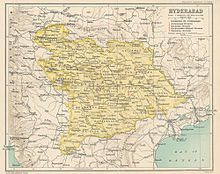| Revision as of 02:28, 9 February 2005 edit128.100.151.103 (talk)No edit summary← Previous edit | Revision as of 02:28, 9 February 2005 edit undo128.100.151.103 (talk)No edit summaryNext edit → | ||
| Line 8: | Line 8: | ||
| The seniormost (21-gun) ] in ], Hyderabad was an 82,000 square mile (212,000 km²) region in the ] ruled by the Asaf Jah dynasty of Muslim rulers, who had the title of Nizam and style of His Exalted Highness. The Nizams ruled over the wealthiest state in ] at that time, controlling some 16,500,000 people. During the height of Hyderabad's wealth in the 1930's the Nizam was the world's richest man, famous for employing 11,000 servants and using the ] as a paperweight. | The seniormost (21-gun) ] in ], Hyderabad was an 82,000 square mile (212,000 km²) region in the ] ruled by the Asaf Jah dynasty of Muslim rulers, who had the title of Nizam and style of His Exalted Highness. The Nizams ruled over the wealthiest state in ] at that time, controlling some 16,500,000 people. During the height of Hyderabad's wealth in the 1930's the Nizam was the world's richest man, famous for employing 11,000 servants and using the ] as a paperweight. | ||
| Geographically, Hyderabad was the size of Italy. Administratively, it was made up of sixteen ]s, grouped into four divisions. ] division included Aurangabad, ], ], and ] districts; ] division included ], Gulbargah, ], and ] districts; ] or Medak division included ], ], ], ], and ] districts, and ] division included ], ], and Warangal districts. | Geographically, Hyderabad was the size of Italy. Administratively, it was made up of sixteen ]s, grouped into four divisions. ] division included Aurangabad, ], ], and ] districts; ] division included ], Gulbargah, ], and ] districts; ] or Medak division included ], ], ], ], and ] districts, and ] division included ], ], and Warangal districts. | ||
Revision as of 02:28, 9 February 2005

Hyderābād was an autonomous princely state of south-central India from 1724 until 1948, ruled by a hereditary Nizam, and an Indian state from 1948 to 1956. Its capital city Hyderabad was for most of that time one of India's four largest cities.
Hyderabad was founded by the Qutb Shahi dynasty of Golconda. In 1686 the Mughal emperor Aurangzeb campaigned in the Deccan to tame the Marathas and conquer the independent Deccan states. Before the campaign, the Mughals had controlled the northwestern Deccan, including Kandesh and Berar, but Mughal control ended at the Godavari River. Aurangzeb conquered Golconda and Bijapur in 1687, extending Mughal control south of the Krishna River.
The Mughal Empire began to weaken during the reign of Aurangzeb's grandson, Muhammad Shah. A Mughal official, Asif Jah, defeated a rival Mughal governor to seize control of the empire's southern provinces, declaring himself Nizam-al-Mulk of Hyderabad in 1724. The Mughal emperor, under renewed attack from the Marathas, was unable to prevent it.
The seniormost (21-gun) princely state in British India, Hyderabad was an 82,000 square mile (212,000 km²) region in the Deccan ruled by the Asaf Jah dynasty of Muslim rulers, who had the title of Nizam and style of His Exalted Highness. The Nizams ruled over the wealthiest state in India at that time, controlling some 16,500,000 people. During the height of Hyderabad's wealth in the 1930's the Nizam was the world's richest man, famous for employing 11,000 servants and using the Jacob Diamond as a paperweight.
Geographically, Hyderabad was the size of Italy. Administratively, it was made up of sixteen districts, grouped into four divisions. Aurangabad division included Aurangabad, Bhir, Nander, and Parbhan districts; Gulbargah division included Bidar, Gulbargah, Osmanabad, and Raichur districts; Gulshanabad or Medak division included Atraf-i-Baldah, Mahbubnagar, Medak, Nalgundah, and Nizamabad districts, and Warangal division included Adilabad, Karimnagar, and Warangal districts.
When India became independent on August 15, 1947, the Muslim Nizam refused to accede to the Indian Union, although it entirely surrounded his territory, demanding the right as ruler of 18 million (overwhelmingly Hindu) subjects to rule a separate state. The resulting standoff ended with the state's occupation by Indian troops between September 13-17, 1948 and its incorporation as a state of India the next year. The current Nizam VIII, Nawwab Mir Barkat Ali Khan ,Mukarram Jah Bahadur, lives in Australia.

In November 1956 the State of Hyderabad was divided along linguistic lines, with the northeastern Telugu-speaking region, including the city of Hyderabad, assigned to the newly created Andhra Pradesh state, the Kannada-speaking western region assigned to the state of Karnataka, and Marathwada, the Marathi-speaking northwestern region of the state, assigned to Bombay state, later Maharashtra.
The Nizams of Hyderabad, 1724-1949
- Qamar ad-Din Chin Qilij Khan Asif Jah I 1724-1748
- Nasir Jang Mir Ahmad 1748-1750
- Muhyi ad-Din Muzaffar Jang Hidayat 1750-1751
- Asif ad-Dawlah Mir Ali Salabat Jang 1751-1762
- Ali Khan Asif Jah II 1762-1802
- Mir Akbar Ali Khan Asif Jah III 1802-1829
- Nasir ad-Dawlah Farkhundah Ali Asif Jah IV 1829-1857
- Afzal ad-Dawlah Mahbub Ali I Khan Asaf Jah V 1857-1869
- Fath Jang Mahbub Ali II Khan Asif Jah VI 1869-1911
- Fath Jang Mir Osman Ali Khan Asif Jah VII 1911-1949